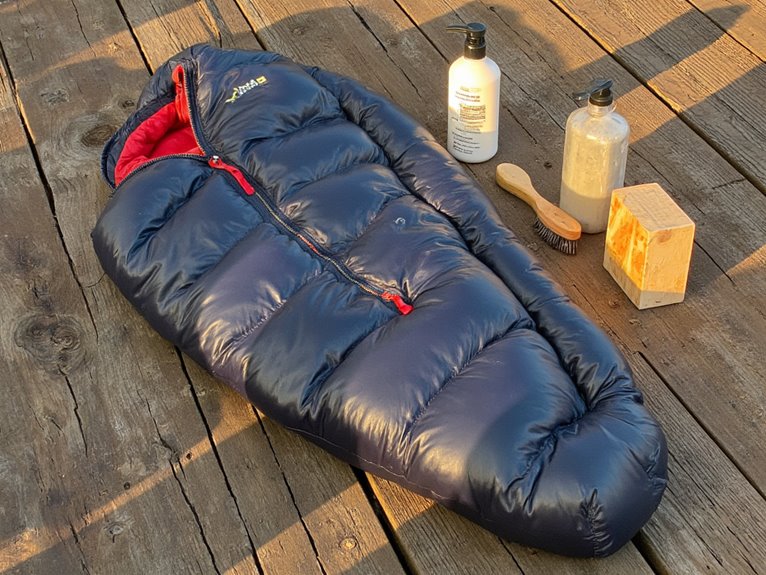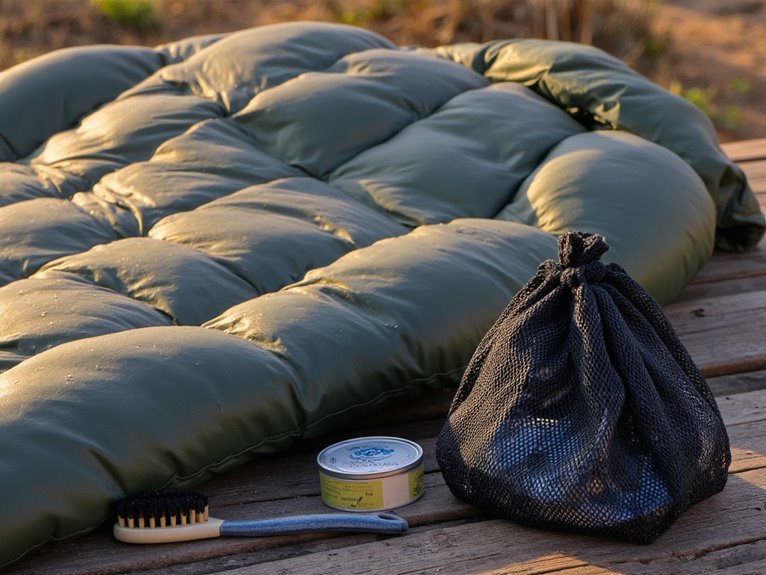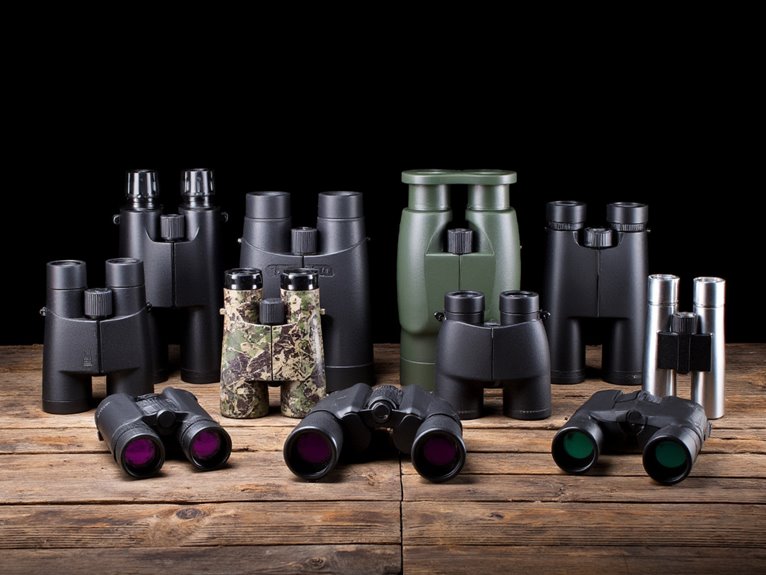Sleeping Bag Maintenance: Cleaning, Storage & Reproofing
Keep your sleeping bag performing at peak efficiency by washing in water below 40°C with specialized detergents like Nikwax Down Wash Direct, avoiding conventional soaps that strip protective coatings. Tumble dry on low heat with tennis balls to restore loft, then store uncompressed in breathable cotton sacks away from temperature fluctuations. Reproofing with DWR treatments maintains water resistance, while regular inspections catch wear patterns before they become failures. Proper maintenance protocols below reveal advanced techniques for maximizing longevity.
We are supported by our audience. When you purchase through links on our site, we may earn an affiliate commission, at no extra cost for you. Learn more. Last update on 27th November 2025 / Images from Amazon Product Advertising API.
Notable Insights
- Use specialty cleaners designed for down or synthetic insulation with water below 40°C to protect fiber integrity.
- Tumble dry on low heat with tennis balls to restore loft, ensuring complete moisture removal before storage.
- Store uncompressed in breathable cotton sacks in cool, dry locations away from temperature fluctuations and direct sunlight.
- Regularly inspect for tears, clumped insulation, and seam deterioration while fluffing fill to maintain proper loft distribution.
- Address zipper jams with gentle extraction and lubrication, and treat persistent odors with enzyme-based sprays or baking soda.
Water Temperature and Detergent Selection for Safe Cleaning
Two critical factors determine whether your sleeping bag emerges from cleaning in peak condition: water temperature and detergent selection.
Keep water below 40°C (100°F) to protect insulation integrity. Cold water works best for synthetic bags, preventing fiber degradation. Down bags tolerate warm water up to the 40°C threshold without losing loft.
Your detergent selection directly impacts performance longevity. Use specialty cleaners formulated specifically for down or synthetic insulation. These products preserve natural oils in down while protecting synthetic fibers from chemical damage.
Avoid conventional detergents, bleach, and fabric softeners—they strip protective coatings and reduce insulation effectiveness. Measure detergent precisely to prevent excessive suds during washing.
Plan multiple rinse cycles to eliminate residue completely, maintaining your bag’s thermal efficiency and fabric durability. Complete two rinse cycles to ensure all soap residues are removed from your sleeping bag.
Specialty Cleaning Products for Down and Synthetic Insulation

The right cleaning product makes the difference between preserving your sleeping bag’s performance and gradually destroying its insulation properties.
Proper cleaning products preserve insulation performance while improper ones gradually destroy your sleeping bag’s thermal efficiency and loft properties.
For down insulation, use specialized detergents like Nikwax Down Wash Direct or Granger’s Down Wash. These formulas avoid clumping while preserving natural oils essential for loft. Standard detergents contain harsh chemicals that damage down clusters and reduce thermal efficiency.
Synthetic insulation requires different washing techniques with performance cleaners designed for polyester fills. These products maintain water repellency without compromising breathability. Product comparisons reveal that synthetic-specific cleansers outperform conventional detergents in preserving loft and drying performance.
Both down and synthetic specialty cleaners feature non-biological formulas that rinse completely, preventing residue buildup.
Many cleaning kits include dryer balls for enhanced loft restoration and DWR treatment sprays for shell reproofing.
Proper Drying Methods to Maintain Loft and Shape
After washing your sleeping bag with the appropriate cleaning products, you’ll need to focus on proper drying techniques that preserve both loft and structural integrity.
Tumble drying techniques require low heat settings and commercial dryers with large capacity drums. Add two to three tennis balls to break up down clumps and restore loft during multiple cycles. Run several hours of drying cycles to guarantee complete moisture removal. High heat will melt nylon fabric and damage insulation.
Air drying benefits include zero heat damage risk and fabric protection. Lay the bag flat on clean surfaces away from direct sunlight to prevent fading.
Distribute weight carefully when hanging to avoid fabric stress. Choose low-humidity areas for faster moisture evaporation. Check overnight for complete dryness before storage.
Proper drying is essential for maintaining insulation quality and performance, as inadequate moisture removal can lead to mold growth and significantly reduce your sleeping bag’s lifespan.
Storage Best Practices for Long-Term Preservation
Once you’ve properly dried your sleeping bag, proper storage becomes critical for maintaining its insulation properties and extending its functional lifespan.
Remove it from the compression stuff sack immediately. The continuous compression destroys loft permanently. Transfer to a large cotton or mesh storage sack that allows natural expansion.
Humidity control and insulation care require specific environmental conditions:
- Store in cool, dry rooms – Avoid attics and basements with temperature fluctuations
- Use breathable cotton storage sacks – Mesh allows airflow but permits dust infiltration
- Maintain stable temperatures – Extreme heat degrades synthetic fills and down clusters
- Keep away from direct sunlight – UV radiation breaks down fabric fibers and coatings
Regular inspection prevents mold growth.
Similar to camping gear like sleeping pads, keep your gear in cool, dry environments to prevent material degradation and maintain optimal performance.
Proper storage maintains original R-values and compressibility ratings for decades.
Waterproofing and Reproofing Techniques
| Treatment Type | Application Method | Breathability Impact |
|---|---|---|
| DWR Treatments | Spray application | Minimal reduction |
| PU Coatings | Factory applied | Moderate reduction |
| Seam Taping | Heat-sealed strips | No impact |
Reproofing techniques require careful execution. Clean your bag in a front-loading machine with gentle detergent first. Apply waterproofing spray to the cleaned bag before drying. Use low-heat settings or air-dry to preserve insulation properties. Avoid over-treatment, which compromises breathability and creates condensation issues inside your bag.
Essential Maintenance Tips for Extended Lifespan

Your sleeping bag’s lifespan depends on three critical maintenance practices that prevent costly replacements and performance failures.
Regular inspection catches small tears before they become major repairs, while proper storage maintains the loft that keeps you warm during cold nights.
Timely cleaning removes oils and dirt that break down insulation fibers, extending your bag’s useful life from the typical 5-7 years to potentially 10-15 years with proper care.
Regular Inspection Prevents Damage
Although sleeping bags appear durable, they’re surprisingly vulnerable to gradual deterioration that can compromise their insulation performance and structural integrity.
Your inspection frequency should match your usage patterns—monthly for frequent camping, seasonally for occasional use.
Damage identification requires systematic examination of critical areas where wear patterns develop.
Regular inspection prevents costly repairs through early detection:
- Check fabric integrity at stress points like shoulders and hips where body pressure creates wear patterns.
- Examine filling distribution by evaluating loft consistency and identifying clumped down or synthetic insulation.
- Inspect moisture damage around hood and collar areas where skin oils accumulate and create mildew conditions.
- Evaluate seam strength at baffle connections where thread degradation causes filling migration.
Document findings to track deterioration patterns over time.
Proper Storage Preserves Loft
When proper storage practices aren’t followed, even premium sleeping bags lose their insulating capacity within months rather than maintaining performance for years. Your storage method directly impacts sleeping bag longevity through moisture control and fill preservation.
Store your bag in breathable cotton or mesh storage sacks, never compression sacks. Hanging on padded hangers prevents localized compaction while maintaining airflow. Control environmental factors by choosing cool, dry locations away from direct sunlight.
| Storage Method | Benefits | Drawbacks |
|---|---|---|
| Breathable Sack | Maintains loft, prevents moisture | Requires more space |
| Hanging Storage | Even air circulation, no compression | Limited closet space |
| Compression Sack | Compact for travel | Damages fill permanently |
Air out your bag twice yearly, checking for moisture or odors. Fluff the fill during inspections to restore loft and prevent clumping.
Timely Cleaning Extends Life
Regular cleaning maintains your sleeping bag’s thermal efficiency by preventing the accumulation of body oils, dirt, and moisture that compromise insulation performance.
Ideal sleeping bag longevity requires strategic maintenance that preserves loft and fabric integrity. Your cleaning frequency should align with usage patterns and exposure conditions.
Essential maintenance practices include:
- Annual washing minimum – Increase to twice yearly for heavy use or extreme conditions
- Technical soap application – Use specialized cleaners like Nikwax Down Wash Direct for material compatibility
- Gentle washing methods – Hand wash in bathtubs or front-loading machines without agitators
- Proper drying support – Prevent baffle damage by supporting wet bags during extraction
Neglected cleaning allows contaminants to migrate into fill material, causing permanent loft reduction.
Body oils create lasting odors while accelerating fabric degradation through chemical breakdown.
Troubleshooting Common Sleeping Bag Care Issues
Even well-maintained sleeping bags can develop issues that compromise their performance and comfort during outdoor adventures.
You’ll encounter three primary problems that require specific troubleshooting techniques: loft loss that reduces insulation efficiency by up to 40%, zipper jams that can permanently damage the closure mechanism, and persistent odors that indicate bacterial growth or improper drying.
These issues demand immediate attention using targeted solutions to restore your bag’s original performance specifications.
When your sleeping bag’s insulation becomes compressed and loses effectiveness, pairing it with a sleeping pad that has the appropriate R-value becomes even more critical to prevent dangerous heat loss through ground contact.
Loft Loss Prevention
Although sleeping bags can lose their insulating power through various factors, you’ll find that most loft degradation is preventable with proper care techniques.
Understanding these loft maintenance tips guarantees your bag maintains peak thermal performance throughout its lifespan.
Effective loft recovery techniques require systematic approaches:
- Store in breathable containers – Never leave your bag compressed in stuff sacks for extended periods, as this breaks down insulation fibers permanently.
- Maintain dry conditions – Moisture causes down clusters to clump and synthetic fills to lose resilience, reducing thermal efficiency by up to 90%.
- Regular fluffing routine – Shake and redistribute insulation after each use to prevent fiber settling and maintain consistent loft distribution.
- Professional reconditioning – Consider expert treatment when standard maintenance fails to restore original loft specifications.
Zipper Jam Solutions
Zipper failures can render even the most well-maintained sleeping bag unusable when you’re facing harsh weather conditions. Common causes include fabric snags, debris accumulation, and warped teeth that prevent smooth operation.
Start with gentle extraction techniques using needle-nose pliers to remove caught fabric without tearing. Clean the zipper track thoroughly to eliminate dirt and debris buildup.
Apply zipper lubrication techniques using silicone spray, candle wax, or graphite pencil along the teeth and track for smooth operation.
When lubrication fails, zipper slider replacement becomes necessary. Remove old stoppers with end nippers, then slide off the worn component.
Install the new slider ensuring proper alignment with teeth positioning. Replace stoppers and test functionality before field use.
Odor Elimination Methods
Persistent odors in sleeping bags stem from identifiable sources that require targeted elimination strategies rather than temporary masking solutions.
Understanding odor sources helps you select appropriate treatments. Moisture creates ideal conditions for bacterial growth and mildew formation. Skin oils transfer during use, creating persistent smell accumulation. Smoke exposure embeds deeply into fabric fibers.
Effective odor prevention starts with proper maintenance protocols:
- Enzyme-based sprays like The Bio one™ break down bacteria causing odors at the molecular level.
- Baking soda treatment absorbs and neutralizes smell molecules when applied before washing cycles.
- MiraZyme application specifically targets musty mold and mildew odors in synthetic and down fills.
- Air drying protocols naturally eliminate lingering odors through proper ventilation exposure.
These methods address root causes rather than masking symptoms temporarily.





